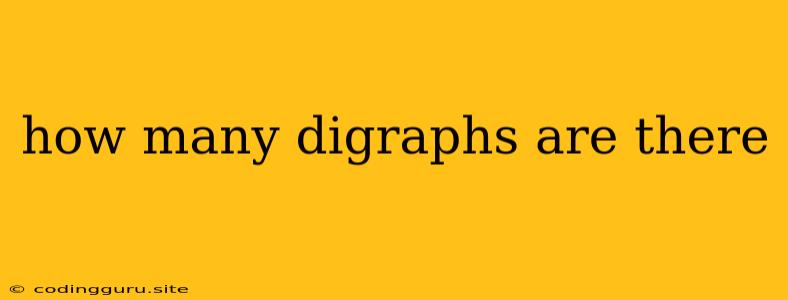How Many Digraphs Are There? Exploring the World of Directed Graphs
The concept of digraphs can seem daunting at first, but it's actually quite simple. Digraphs are a special type of graph that represents relationships between entities, but with an added layer of directionality. Think of them as road maps where you can only travel in one direction on each road. This directional aspect is crucial for understanding how digraphs are used in various applications.
So, how many digraphs are there? This question might seem simple, but it's not as straightforward as it appears. It depends on what information we have about the digraph. Let's delve into this fascinating world of directed graphs to find out.
Understanding the Basics
To count the number of possible digraphs, we need to first define the components of a digraph.
- Vertices: These are the points or nodes in the digraph representing the entities. Imagine these as cities on a map.
- Edges: These are the connections between the vertices. Think of these as roads connecting the cities. In a digraph, each edge has a specific direction.
Counting Digraphs: The Key Factors
To figure out how many digraphs exist, we need to consider two key factors:
- Number of Vertices (n): This is the number of points or nodes in the digraph.
- Number of Edges (m): This is the number of directed connections between the vertices.
The Number of Possible Digraphs
- Maximum Edges: The maximum number of edges a digraph with n vertices can have is n(n-1). This is because each vertex can connect to every other vertex in the digraph in both directions.
- Counting Possibilities: For each possible edge, we have two options: either it's present or it's not. This means, with n vertices, we have n(n-1) choices to make, each with two possibilities.
The Formula
So, how many different digraphs are possible with n vertices? The answer lies in the power of 2:
2^(n(n-1))*
This formula represents the total number of possible digraphs with n vertices, taking into account all the possible combinations of edges.
Examples
Let's look at some examples to solidify our understanding:
- Digraph with 2 Vertices: We have 2 * (2 - 1) = 2 possible edges. Each edge has two possibilities: present or absent. This gives us 2² = 4 possible digraphs.
- Digraph with 3 Vertices: We have 3 * (3 - 1) = 6 possible edges. Each edge has two possibilities: present or absent. This gives us 2⁶ = 64 possible digraphs.
Important Note
The formula 2^(n*(n-1)) gives us the total number of possible digraphs, including those with no edges at all. This means that it includes all the possible directed relationships between the vertices, regardless of whether they are connected or not.
Beyond the Formula
While the formula provides a general framework, it's essential to remember that the number of digraphs can be further narrowed down based on specific conditions:
- Specific Number of Edges: If we know the exact number of edges in the digraph, the number of possible digraphs will be significantly reduced.
- Connectivity Requirements: We can impose restrictions like requiring the digraph to be connected (meaning there's a path between any two vertices) or acyclic (meaning there are no cycles or loops). These constraints will further impact the number of possible digraphs.
Applications of Digraphs
Digraphs are crucial in various fields:
- Computer Science: Analyzing algorithms, modeling networks, and representing dependencies.
- Social Sciences: Understanding social networks, information flow, and influence.
- Biology: Modeling gene regulatory networks and protein interaction pathways.
- Transportation: Planning routes, optimizing traffic flow, and analyzing transportation networks.
Conclusion
The number of digraphs with n vertices is vast, encompassing all possible directed relationships between the nodes. While the formula 2^(n*(n-1)) provides a general framework, the specific number can vary greatly based on conditions like the number of edges, connectivity requirements, and other factors. The versatility of digraphs makes them invaluable tools for representing complex relationships in various domains, leading to new insights and applications.
